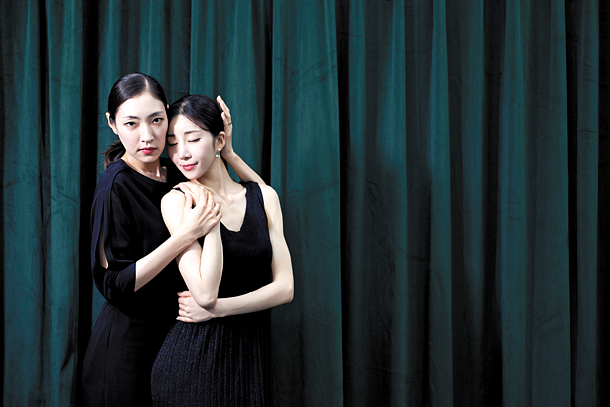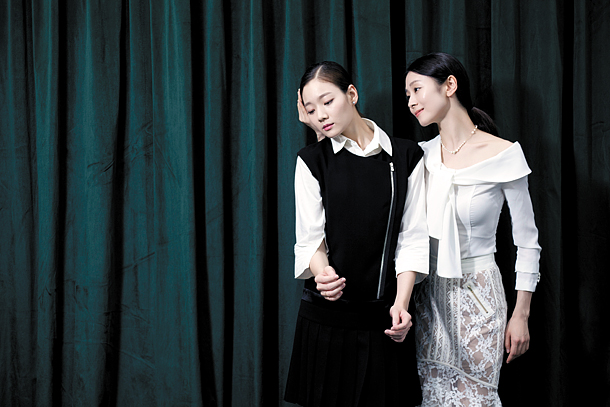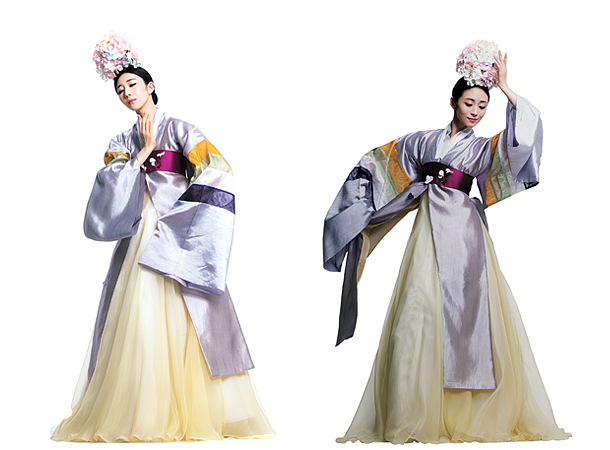Female friendships take center stage in ‘Lee Jin’ : Beauty and pain of growing up creates tension

Lee Ui-yeong, right, and Jang Yun-na, who respectively plays Lee Jin and Do Hwa. [JEON HO-SUNG]
Depicting love, friendship, jealousy and lust between court dancers set in the Joseon Dynasty (1392-1910), “Lee Jin” is an effort to “open the new era of dance drama by reflecting periodic changes,” according to Ahn Ho-Sang, CEO of the National Theater of Korea.
With an emphasis on conflict and a dramatic plot, “Lee Jin” is a popular dance drama that takes place in a world created by set designer Jeong Seung-ho and composer Kim Seong-guk.
To learn more about the upcoming performance, S Magazine, an affiliate of the Korea JoongAng Daily, met up with the four dancers cast to play the two main characters: Lee Jin and Do Hwa.

Lee Yo-eum, right, and Park Hye-ji, who each play Lee Jin and Do Hwa. [JEON HO-SUNG]
Lee Jin was a real person who appears in “En coree,” written by Hippolyte Frandin, who served as the French consul in Korea in the early 1890’s. But the dance drama “Lee Jin” is a complete fiction. The story follows the rough structure of the original text, which follows Lee Jin heading to France with the French minister after the two fall in love. However, characters like Do Hwa and Won U have been added to maximize conflict and choreography in the performance.
“[‘Lee Jin’] reminds me of the choreography philosophy of [ballet dancer and choreographer] John Cranko, who successfully communed with the audience through delicate depiction of characters and realistic details,” said dance critic Jang In-ju after seeing the casts’ practice scene.
“If [late Korean dancer] Song Beom’s dance drama style is a classic ballet, ‘Lee Jin,’ which is closer to a modern dance drama is a reminder of ballet drama.”
The key to “Lee Jin” is drama. The mix of love, friendship and jealousy between Lee Jin (Lee Ui-yeong, Lee Yo-eum) and Do Hwa (Jang Yun-na, Park Hye-ji) was seen as the dancers continuously showed strong emotions when pulling off the roles.
Artistic director Kim Sang-duk said that “[‘Lee Jin’] is aiming to become a movie-like dance drama,” which is one of the most challenging parts of the performance, according to the dancers who unanimously said that “acting was the most difficult” element of the show.
The show starts off with a conversation between Lee Jin and Do Hwa: “Though people die, dance lives on beside us, and we are still dancing.”
Though it is a short, single sentence shared by two women, it is the most difficult scene for them.
“Breaking the first word was so difficult since it was my first time saying a line out loud. Dancing is a lot easier. I didn’t realize how difficult speaking could be,” said Yo-eum.
“I’ve never staged a performance that has so many lines that describe my feelings. I have to continuously say the lines and also [simultaneously] express those words through body gestures, making myself so busy,” said Ui-yeong.
“Though Chunhyang and Simcheong are characters that everybody knows, Lee Jin and Do Hwa are unfamiliar characters, especially since Do Hwa is a fictional figure. [Do Hwa] seems to have at least 10 different identities, and I agonize everyday about how I should pull off those [identities’] different emotions,” said Yun-na.
“[Since practicing for the performance], I [started] to look closely at TV dramas. Actors suddenly started to seem so extraordinary,” said Hye-ji.

Royal court dancer Do Hwa, who betrays her friend to fulfill her desire, in the upcoming performance “Lee Jin.” [NATIONAL DANCE COMPANY]
“It’s like the new world of Korean dance. Though the performance includes bits of improvisation and bits of [distinct] Korean themes, there are many elements and moves that come from contemporary and modern dance,” said Hye-ji, who added that the first and the second parts are completely different in that the former is formal while the latter is much more less structured and modern, as seen by the sounds of Brazilian percussion instrument.
“Even we were very surprised [about how different the two parts are]. I believe [the second part] depicts Lee Jin’s experience of encountering a new world (France), and adjusting to the new environment,” said Ui-yeong.

Royal court dancer Lee Jin, the longtime best friend of Do Hwa, believes in innocent love. [NATIONAL DANCE COMPANY]
There is also an unexpected surprise in the performance. As Do Hwa is seen to hug Lee Jin in the main poster, it is implied that there is a same-sex relationship in the performance, a first in Korean dance. Though the main plot revolves around the love story between Lee Jin and Frandin, the love-hate relationship between Lee Jin and Do Hwa, driven by Do Hwa’s jealousy and desire for Lee Jin, is a notable part of the performance.
“We all have a best friend when we are young. Someone we share our diary with and go to the bathroom with. Do Hwa feels betrayed by Lee Jin, when she suddenly starts looking at a different point of life after sharing the same perspective for so many years. It’s like the feeling of sadness turning into obsession,” said Hye-ji about her character.
Even the dancers say that it feels different to be partnered with another female instead of a male.
“Even if it’s the same move, holding hands with a woman feels different from holding hands with a man. I think [the lesbian theme] is fun since it’s not a usual attempt. I believe we will end up with something very unique,” said Yun-na.
“Hye-ji and I have known each other since middle school, so we know how the other feels just by looking at each other,” said Yo-eum. “We understand each other very well, but [while practicing], I sometimes questioned whether I actually like Do Hwa (played by Hye-ji).”
Both characters have unique charms, according to the cast.
“Lee Jin is like a woman with an innocent heart like pure white cotton who naively accepts new experiences. Though she ends her life tragically, she doesn’t resent anyone and just accepts fate,” said Ui-yeong.
“I wonder whether it would have been possible to have the courage to go over to France at that period of time just for the sake of love. Her charms are innocence and bravery. How to play out these qualities on the stage will be homework for me,” said Yo-eum.
“Though Do Hwa is an ambitious, nasty character who directly vents her anger, her way of following her instinct seems very daring and brave. I’m trying to get vicarious satisfaction [through the character] since I don’t have those qualities [in real life,]” said Hye-ji.
When asked about each person’s most memorable part, both Lee Jins and Do Hwas chose the same scene.
For the two dancers playing Lee Jin, the most memorable part for them was when the character meets Do Hwa in her dream after marrying the French consul. For the dancers who play Do Hwa, their most memorable part was when she solely mourns the death of Lee Jin.
“I believe the memories [Lee Jin] had of Do Hwa in the dream contain a number of meanings. [To Lee Jin], Do Hwa is herself, a friend and home,” said Ui-yeong.
The four dancers, who will be on stage from June 28 through July 1 at the Haeoreum Theater of the National Theater of Korea in Jung-gu, central Seoul, said they hope for audiences to enjoy the show with an “open mind,” and regard the performance as “a part of a process in finding the color of Korean dance.”
BY YOO JU-HYUN [jin.minji@joongang.co.kr]
사랑과 욕망의 강렬한 드라마 ‘리노베이션 무용극’의 탄생
확 달라진 무용극을 만난다. 국립극장의 2016-2017 레퍼토리 시즌 폐막작이자 국립무용단이 5년 만에 선보이는 신작 무용극 ‘리진’(6월 28일~7월 1일 국립극장 해오름극장)이다. 지난 연말 부임한 김상덕 예술감독은 자신의 첫 안무작을 통해 “3세대 무용극으로 세대교체를 이루겠다”는 포부다.
무용극은 1962년 국립무용단 창단 이래 줄곧 한국무용계를 이끌어온 장르다. 하지만 오랫동안 고전이나 설화, 굿 등 예스러운 소재와 클래식발레에서 차용한 형식의 틀에 머물면서 관객에게서 멀어져갔다. 국립무용단도 한동안 컨템포러리 작업에 전념하며 무용극을 포기하는 듯했지만, 5년의 공백을 깨고 ‘리노베이션 무용극’으로 화려한 컴백을 선언했다. 안호상 국립극장장은 “시대적 변화를 수용한 새로운 무용극의 시대를 열겠다”며 “다음 시즌 개막작도 무용극으로 준비 중”이라고 밝혔다.
김탁환·신경숙의 소설로도 익숙한 ‘리진’은 조선의 마지막 궁중 무희를 둘러싼 사랑과 우정, 질투와 욕망이 얽힌 흥미진진한 플롯으로 재탄생했다. 무용극에 걸맞게 갈등 구조를 극대화한 강렬한 드라마로 승부하는 대중적 무대다. 정승호 디자이너의 시적인 무대 미술과 김성국 작곡가의 서정적인 음악도 기대를 더한다.
궁중무희들의 이야기는 곧 국립무용단 무용수들의 이야기이기도 할 터다. 15일 막바지 연습이 한창인 연습실을 찾아 주인공 리진과 도화에 더블캐스팅된 장윤나(35)·이의영(34)·박혜지(29)·이요음(28)과 함께 무용극 ‘리진’을 미리 만났다.
리진은 1890년대 조선에 주재했던 프랑스 공사 이폴리트 프랑댕이 쓴 『앙 코레』에 등장하는 실존 인물이다. 그런데 무용극 ‘리진’은 거의 완벽한 픽션이다. 궁중무희 리진이 프랑스 공사 플랑시의 사랑을 받아 프랑스로 건너갔다가 비극적인 죽음을 맞는다는 원전의 얼개를 토대로 가상의 인물 도화와 원우까지 등장시켜 무용적 요소와 갈등구조를 확장시켰다. 연습 현장을 지켜본 장인주 무용평론가는 “섬세한 인물 묘사와 사실적 표현으로 관객과의 교감에 성공한 존 크랭코의 안무철학이 엿보인다”며 “송범식 무용극이 고전발레라면 현대판 무용극 ‘리진’은 드라마 발레를 연상시킨다”고 평했다.
그의 말대로 ‘리진’의 키워드는 드라마다. 리진(이의영·이요음)과 도화(장윤나·박혜지)의 사랑과 우정, 플랑시와 리진의 사랑, 원우와 도화의 욕망과 질투가 얽히고설킨다. 그런 만큼 극을 이끌어 가는 무용수들의 얼굴엔 시종 강렬한 감정이 교차했다. “한 편의 영화같은 무용극을 지향한다”는 김 예술감독의 말처럼 무용수들도 “연기가 가장 어렵다”고 입을 모았다. 오프닝도 리진과 도화의 대사로 시작된다. “사람은 죽지만 춤은 살아 곁에 있고, 우리는 지금도 그 춤을 추고 있는 게야”라는 짧은 한 문장을 두 여인이 주거니 받거니 완성하는 게 다지만, 무용수들에겐 가장 어려운 장면이다.
“첫 마디 떼기까지가 너무 힘들었어요. 대사를 처음 해 보니까요. 차라리 춤이 쉽지, 말이 이렇게 어려운 건지 몰랐어요.”(이요음, 이하 ‘요’)
“마음 속의 대사가 이렇게 많은 작품은 처음이에요. 속으로 끊임없이 대사를 해야 하는데, 그걸 또 몸짓언어로 표현해야 하니까 바쁘네요.”(이의영, 이하 ‘의’)
“춘향이나 심청은 다들 아는 캐릭터지만 리진과 도화는 생소하고 특히 도화는 가상 캐릭터니까요. 자아가 10개는 돼 보이는데, 그 감정 표현들을 어떻게 해결할지 매일 고민하고 있어요.”(장윤나, 이하 ‘장’)
“전에 없이 TV드라마를 유심히 보게 돼요. 배우들이 새삼 대단해 보이더군요.”(박혜지, 이하 ‘박’)
작품은 크게 2막으로 나뉜다. 1막은 조선 왕실을 배경으로 하는 ‘고전’ 파트, 2막은 프랑스에서 새로운 삶을 맛보다 비극적 최후를 맞는 ‘신세계’ 파트다. 그런데 ‘신세계’ 파트는 파격 그 자체다. 경쾌한 테크노 음악을 배경으로 한바탕 축제처럼 결혼식 장면이 펼쳐지는데, ‘한국무용’의 범주에서 예측하기 힘든 놀라운 춤판이 벌어진다.
“한국무용의 신세계랄까요. 즉흥적인 것도 있고 한국적 색깔도 들어가지만 컨템포러리에 가까운 움직임도 많고 현대무용적인 요소도 많죠. ‘고전’ 파트가 그래도 좀 격식을 갖췄다면, ‘신세계’ 파트는 완전 다른 느낌이에요. 브라질 타악기까지 등장하죠.”(박)
“저희도 놀랐어요. 리진이 신세계에서 예상치못한 경험을 하며 적응하는 이야기니까 그런 반전으로 표현하는 것 같아요.”(의)
“처음엔 솔직히 장난인줄 알았어요. 혼란도 오긴 했는데 아프리카 부족 춤처럼 ‘으쌰으쌰’하는 느낌을 원하시는 것 같아요.”(요)
“허를 찌르는 거죠. 굳이 분석이 필요없이 단순하게 보라는 건데, 그냥 신나게 본능에 맡기는 축제랄까요.”(장)
‘리진’에는 의외의 관전 포인트가 있다. 도화가 리진을 끌어안고 있는 메인포스터 이미지에서 볼 수 있듯, 한국무용 최초로 시도되는 두 여인의 동성애 코드다. 원전과 소설의 메인 플롯은 리진과 플랑시의 사랑이지만, 무대에서는 가상 캐릭터인 도화의 질투와 욕망이 부각되면서 리진과 도화의 애증 구도가 중심을 이룬다. 순수하고 사랑스런 리진과 욕망의 화신인 도화는 마치 백조와 흑조처럼 대조적인 매력이다. “어릴 때 단짝친구 한 명씩 있쟎아요. 교환일기 쓰고 화장실도 꼭 같이 가고. 도화 입장에선 어려서부터 같은 곳만 바라보다 다른 곳을 보게 된 리진에게 배신감을 느끼죠. 서운함이 변질돼 집착하는 느낌이랄까요.”(박)
질의: 뻔한 남녀 2인무보다 여성 2인무 느낌이 색다르던데요.
응답 :의: 굉장히 미묘한 느낌이에요.(웃음) 남성무용수와는 전혀 다르죠.
장: 같은 동작이라도 남녀가 손잡을 때와 전혀 달라요. 흔치 않은 시도라 재밌는 것 같아요. 개성 강한 그림이 나오지 않을까 싶어요.
요: 혜지 언니와는 중학교 때부터 쭉 봐왔기 때문에 눈빛만 봐도 아는 사이거든요. 같이 할 때도 통하는 부분이 많은데, 순간적으로 ‘내가 도화를 실제로 좋아하나?’ 착각이 들기도 해요.(웃음)
질의 :리진과 도화 각 캐릭터의 매력이라면.
응답 :의: 리진은 그 시대에 특별한 경험을 받아들이는 감정선이 매력 포인트죠. 새하얀 천에 색이 스며들듯 순수한 마음으로 새로운 경험을 받아들였던 특별한 여자의 인생이랄까. 결국 불행하게 생을 마감하지만 누구도 원망하지 않고 자신의 운명을 받아들이죠.
요: 그 시대에 사랑 하나로 프랑스로 건너가는 용기가 가능했을까 싶어요. 바보처럼 순수하면서도 용감한 성격이 매력인데, 그걸 무대에서 잘 풀어내는 게 숙제죠.
박: 도화는 욕망의 화신에다 선택받지 못한 분노를 대놓고 분출하는 얄미운 캐릭터지만, 욕망을 본능적으로 쫓는 모습이 대담하고 용기있어 보여요. 제게 없는 부분이라 대리만족 중이죠.(웃음)
장: 처음부터 악한 사람은 없는 것처럼 결국 도화도 상황이 악녀로 만들었을 뿐 똑같은 사람이었다는 느낌이거든요. 여자들의 사랑과 우정이 잘 보여졌으면 해요.
각자의 ‘킬링파트’를 물으니 두 리진과 두 도화의 대답이 일치했다. 리진에게는 결혼식 이후 꿈속에서 도화를 만나는 장면, 도화에게는 리진의 죽음 이후 홀로 애도하는 솔로 파트란다.
“꿈 속에서 도화와의 추억을 회상하는 2인무에 여러 의미가 포함된 것 같아요. 도화는 자기 자신이자 친구이자 고향 같은 존재니까요.”(의)
“저도 그 장면에서 울컥하곤 해요. 1막에 ‘눈물’ 씬이 있는데, 리진이 도화 때문에 슬퍼하고 내쳐지는 장면이거든요. 거기서부터 연결되는지라 더 그런 것 같아요.”(요)
“리진이 죽고 도화가 복잡미묘한 감정으로 애도의 춤을 춰요. 엔딩 장면인데 아직 안무가 안 나와 설레는 마음으로 기다리고 있어요.”(장)
“결국 도화의 욕망 때문에 리진이 죽게 되는 거라 애도의 춤이 각별한 것 같아요. 멋진 그림이 나올 거라 믿어요.”(박)
175cm에 달하는 놀라운 기럭지의 ‘장신팀’ 장윤나·이의영 커플과 역시 170cm가 넘지만 상대적으로 아기자기한 느낌의 박혜지·이요음 커플은 언니팀과 동생팀으로 선의의 경쟁을 하게 됐다. 김 예술감독이 “국립무용단의 이야기”라고 한 만큼 리진과 도화처럼 이들에게서 경쟁과 질투 코드를 읽어보려 했지만, 쉽지 않았다. 서로의 모습을 거울삼아 좋은 피드백을 주고받고 있단다.
“의영 언니는 주역을 많이 해봐서 그런지 내면적인 감정선을 끌어가는 연구를 정말 많이 하세요. 그 연륜에서 엄청 배우고 있죠.”(요)
“요음이는 동선이나 제스처가 워낙 사랑스럽거든요. 저도 슬쩍 따라해 보기도 하고 그래요.(웃음)”(의)
“전부터 존경해온 윤나 언니와 같은 역할에 캐스팅된 것 자체가 감격이죠. 제가 미숙한 부분을 언니가 터놓고 얘기해주니 캐릭터·연기·춤 모든 면에서 큰 도움을 받고 있어요.”(박)
“혜지는 워낙 몰입도가 좋죠. ‘회오리’ 때 듀엣 추던 혜지의 표정을 잊을 수가 없어요. 춤에 정말 푹 빠져 있구나 느꼈죠. 볼수록 색깔이 많은 친구예요.”(장)
이들은 과도기에 있는 우리 무용극을 “열린 마음으로 봐달라”(장)고 당부했다. 여러 색깔이 혼재하는 ‘리진’은 “한국무용 색깔을 찾아가는 작업”(요) 이라는 것이다. “요즘은 현대무용이나 발레가 한국적인 걸 추구하고 우리는 모던 쪽으로 움직이니 어느 시점에서 소실점처럼 만나는 부분이 있는 것 같아요. 하지만 잠시 만날 뿐, 각자의 넓은 길이 있는 거겠죠.”(의)
유주현 객원기자










with the Korea JoongAng Daily
To write comments, please log in to one of the accounts.
Standards Board Policy (0/250자)